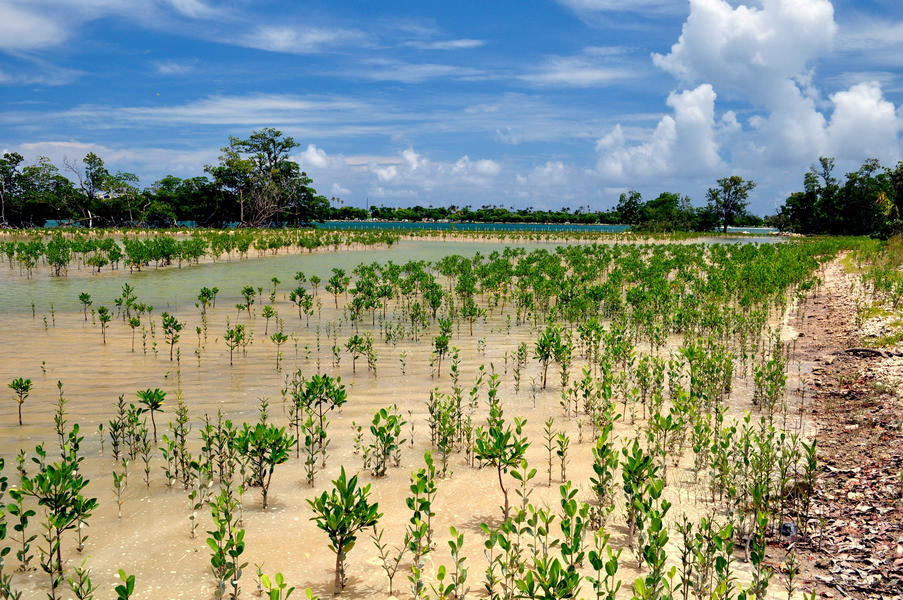Water quality monitoring plays a major role in the understanding of natural and human impacts on coastal waters. Researchers use water quality data to document short- and long-term changes within the water column in an effort to quantify the spatial and temporal variability and trends. Accordingly, it is essential to develop a proficient water quality monitoring program to recognize and prevent potential negative impacts to the aquatic preserve.
A healthy water body contains a balanced amount of nutrients and normal fluctuations in salinity and temperature. It also has plenty of oxygen, a basic requirement for nearly all aquatic biota, and minimal suspended sediment, so that living aquatic resources can breathe or receive enough sunlight to grow. Nutrients, such as nitrogen and phosphorus, occur naturally in water, soil and air. Just as nutrient fertilizers promote plant growth on lawns and farm fields, nutrients in the water encourage the growth of aquatic plants and algae. Although nutrients are an essential part of the ecosystem, an excess of these nutrients can be harmful. This is called nutrient pollution. The two general sources of adverse impacts on water quality are point and nonpoint source pollution. Point source pollution can be traced to a single identifiable source, such as a discharge pipe. Nonpoint source pollution in Citrus County originates from various diffused sources such as, but not limited to, stormwater runoff, development and agriculture. These sources aid in the transport of excess nutrients into the aquifer through the natural recharge process. When these nutrient sources are not managed properly, elevated nutrient levels enter the fresh water tributaries, the Crystal and Homosassa Rivers, and via the spring vent systems leading from the Floridan Aquifer. Increased nutrient levels, such as total nitrogen and total phosphorous, can cause habitat degradation, fish kills, and closure of shellfish beds and swimming areas.
St. Martins Marsh Aquatic Preserve’s current water quality monitoring project utilizes several methods to examine water column characteristics. Basic water quality parameters are monitored, and this data provides information to assess the condition of biological assemblages. To properly assess water quality conditions, long-term data sets are used to develop baseline data. While routine water quality monitoring detects effects of nutrient enrichment, it is not designed to detect trace levels of toxicants or contaminants. Biological assessments, coupled with habitat assessment, such as physical and chemical measurements, will aid in identifying probable causes of impairment not detected by physical and chemical water quality analyses alone, such as nonpoint source pollution and contamination, erosion or poor land use practices. Continued long-term water quality monitoring is necessary and essential to protect the valuable natural resources in the aquatic preserve.
Staff use YSI and EXO datalogger equipment at priority locations that provide continuous in-situ measurements for the following water quality parameters: temperature, specific conductivity, salinity, dissolved oxygen, pH, turbidity, and depth. This data is compiled to evaluate water quality status and trends. In addition to the continuous water quality monitoring program, St. Martins Marsh Aquatic Preserve recently completed a 22-year partnership with UF’s Project COAST to determine total nitrogen and phosphorous, chlorophyll, and water clarity in estuarine systems. This project requires the collection of water samples and relevant data once a month at the designated sampling sites. Monitoring efforts began in 1997, and aquatic preserve staff assisted with sample collection in the Withlacoochee, Crystal and Homosassa Rivers. As of 2020, UF contractors perform monthly sampling to carry on Project COAST within St. Martins Marsh Aquatic Preserve.
Staff also conduct biological assessments and monitor the distribution and abundance of specific indicator species, including scallops and seagrass, to determine the ecological health of the bay system. As needed, staff will contribute and assist in the development of technical reports assessing the status of these resources, areas of concern, and recommendations.
Education and outreach is an important part of maintaining and improving water quality. In addition to brochures and kiosks about water quality, staff are coordinating public lectures to discuss water quality issues and methods for improving water quality.


